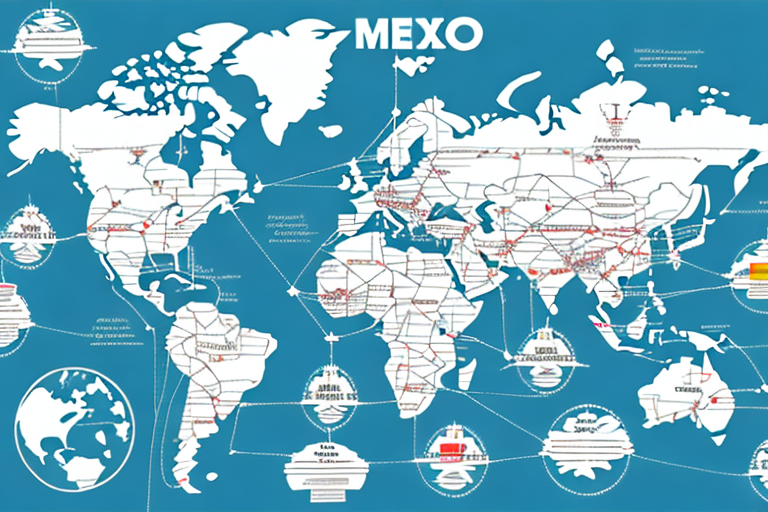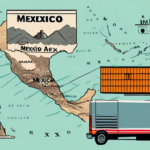Comparing Shipping Rates for UPS, FedEx, and DHL from Mexico to the US
Sending packages from Mexico to the United States can be a complex process, especially when considering the cost of shipping. Businesses and individuals alike must evaluate various factors to determine the most cost-effective and reliable shipping provider. Three of the leading international shipping companies—UPS, FedEx, and DHL—offer a range of services and options for shipments from Mexico to the US. This article explores the key factors influencing shipping rates and provides a comparative analysis of each provider's strengths and weaknesses.
Factors that Affect Shipping Rates between Mexico and the US
Several key factors influence international shipping rates from Mexico to the United States:
- Package Dimensions and Weight: Larger and heavier packages generally incur higher shipping costs.
- Origin and Destination: The specific cities or regions in Mexico and the US can affect the rate due to varying logistics and distance.
- Shipping Service Level: Options like express, standard, or economy shipping impact the cost and delivery speed.
- Customs Duties and Taxes: Import duties, taxes, and fees can add to the overall cost of shipping.
- Mode of Transportation: Air shipping is faster but more expensive, while sea shipping is slower but more economical for bulk shipments.
- Type of Goods: Certain items may require special handling, packaging, or permits, affecting the shipping rate.
- Volume of Shipments: Higher volume shipments can benefit from bulk discounts and lower per-package rates.
Understanding these factors is crucial for businesses and individuals seeking to minimize shipping costs while ensuring timely and secure delivery of their packages.
How UPS, FedEx, and DHL Calculate Shipping Rates from Mexico to the US
UPS, FedEx, and DHL calculate shipping rates based on a combination of factors, including the package's weight, dimensions, and destination. Additionally, these providers consider any additional services requested, such as express delivery, insurance, and specialized handling, which can significantly influence the final cost.
All three companies utilize a tiered pricing system, meaning that the more packages a business ships, the lower the cost per shipment tends to be. This volume-based discount structure rewards businesses with high shipping volumes by offering reduced rates as their shipping volume increases.
- Fuel Prices: Fluctuations in fuel costs directly affect shipping rates, as transportation is a major component of overall shipping expenses.
- Currency Exchange Rates: Exchange rate volatility between the Mexican Peso and the US Dollar can influence the cost of international shipping services.
- Government Regulations: Trade policies, tariffs, and import/export restrictions enacted by either country can affect shipping costs and procedures.
Given these dynamic factors, shipping rates are subject to regular fluctuations, making it imperative for businesses to stay informed about current market trends to optimize their shipping strategies.
Each shipping provider maintains a unique set of rules and regulations for cross-border shipments. For instance, certain products may be restricted or require additional documentation, such as permits or certificates, depending on the nature of the goods and the countries involved. Businesses must familiarize themselves with these requirements to ensure compliance and avoid potential delays or fines.
Furthermore, taking advantage of bulk shipping discounts or negotiating customized rates with preferred shipping providers can lead to significant cost savings. It's advisable for businesses to compare rates and services across different providers to secure the most advantageous shipping arrangements.
Understanding Shipping Costs for Different Types of Packages
Shipping costs are primarily determined by the weight and dimensions of the package. Lightweight and compact packages typically incur lower shipping fees compared to bulky or heavy items. For businesses handling a high volume of shipments, optimizing packaging to reduce size and weight without compromising the integrity of the goods can lead to substantial savings over time.
- Destination: Shipping to remote or less accessible areas often results in higher costs due to longer transit routes and potentially limited service options.
- Shipping Method: Selecting expedited shipping methods, such as overnight or two-day delivery, will generally be more expensive than standard or economy options. However, for time-sensitive shipments, the additional cost may be justified by the need for prompt delivery.
- Type of Goods: Perishable items, hazardous materials, or fragile goods may require special packaging and handling, increasing the overall shipping cost.
According to a 2022 study by the International Shipping Bureau, businesses that strategically manage their packaging and choose optimal shipping methods can reduce their shipping costs by up to 15% annually.
Considering these elements allows businesses and individuals to make informed decisions when selecting the most cost-effective shipping solutions that meet their specific needs.
The Pros and Cons of Using UPS for Shipping between Mexico and the US
UPS is one of the most recognized shipping companies globally, offering an extensive range of services that cater to various shipping needs. Here are the key advantages and disadvantages of using UPS for shipping between Mexico and the United States:
Pros
- Extensive Network: UPS has a robust international presence, ensuring reliable delivery services between Mexico and the US.
- Local Partnerships: UPS collaborates with local carriers in Mexico, facilitating seamless customs clearance and efficient delivery.
- Advanced Tracking: The company provides a sophisticated real-time tracking system, allowing customers to monitor their shipments at every stage.
- Eco-friendly Options: UPS offers a variety of sustainable packaging solutions, appealing to environmentally conscious businesses and consumers.
- Comprehensive Service Offerings: From express delivery to freight services, UPS caters to a wide range of shipping requirements.
Cons
- Higher Costs: UPS tends to be more expensive compared to other shipping providers, which may be a barrier for small businesses or individual shippers.
- Strict Delivery Requirements: The company enforces rigorous guidelines for package dimensions, weight, and labeling, which can be challenging for some users to navigate.
Despite the higher costs, UPS's reliable service and advanced tracking features make it a strong contender for businesses prioritizing speed and reliability in their shipping operations.
The Pros and Cons of Using FedEx for Shipping between Mexico and the US
FedEx is renowned for its reliability and speed in international shipping, offering a comprehensive suite of services tailored to various business needs. Below are the primary advantages and disadvantages of using FedEx for shipping between Mexico and the United States:
Pros
- Global Reach: FedEx operates an extensive global network, ensuring efficient delivery services between Mexico and the US.
- Reliability and Speed: Known for timely deliveries, FedEx offers expedited shipping options that meet tight deadlines.
- Expertise in Cross-Border Shipping: With over 30 years of experience in Mexico, FedEx has a deep understanding of local customs regulations, reducing the likelihood of shipment delays.
- Bilingual Customer Service: FedEx provides customer support in both English and Spanish, facilitating smoother communication for users in Mexico.
- Customized Shipping Solutions: FedEx offers specialized services for various industries, accommodating unique shipping requirements.
Cons
- Higher Costs: Similar to UPS, FedEx's premium services come at a higher price point, which might not be ideal for all budgets.
- Complex Service Offerings: The wide range of services can be overwhelming for new users, potentially complicating the selection of the appropriate shipping option.
FedEx's strong emphasis on reliability and customer support makes it a valuable option for businesses that require dependable and timely shipping services across the Mexico-US border.
The Pros and Cons of Using DHL for Shipping between Mexico and the US
DHL stands as the third-largest international shipping company, offering a wide range of services with competitive pricing. Here are the main pros and cons of utilizing DHL for shipping between Mexico and the United States:
Pros
- Affordable Shipping Rates: DHL is known for offering cost-effective shipping options, making it an appealing choice for budget-conscious businesses.
- Excellence in Customer Service: DHL prides itself on providing exceptional customer support, enhancing the overall shipping experience for users.
- Expanding Network in Mexico: Recent expansions in DHL's Mexico operations have improved transit times and service reliability, making it a more viable option for cross-border shipping.
- Customizable Shipping Options: DHL offers a variety of service levels, including express and economy options, allowing businesses to choose based on their specific shipping needs.
- Strong Global Reach: With a presence in over 220 countries and territories, DHL facilitates efficient international shipping beyond the Mexico-US corridor.
Cons
- Less Extensive Network Compared to UPS and FedEx: While DHL has a significant global presence, its network in certain regions may not be as comprehensive as those of UPS or FedEx, potentially leading to longer transit times for specific routes.
- Variable Transit Times and Costs: Depending on the destination and service level selected, shipping costs and delivery times with DHL may vary, sometimes resulting in higher expenses for certain shipments.
Overall, DHL's combination of affordability and reliable customer service makes it a competitive option for businesses seeking flexible and cost-effective international shipping solutions between Mexico and the US.
How to Choose the Best Shipping Provider for Your Business Needs
Selecting the most suitable shipping provider is crucial for optimizing your business operations and ensuring customer satisfaction. When choosing a shipping provider for shipments between Mexico and the United States, consider the following factors:
- Volume of Packages: Evaluate your shipping volume to determine if you qualify for volume discounts or bulk shipping rates offered by providers.
- Destination Specifics: Consider the geographical locations you frequently ship to and assess each provider's coverage and reliability in those areas.
- Delivery Time Requirements: Determine your delivery speed needs—whether you require express services for urgent shipments or if standard delivery timelines are acceptable.
- Cost: Analyze the overall cost structure, including base rates, surcharges, and additional fees, to ensure it aligns with your budget constraints.
- Reliability and Track Record: Research each provider's reputation for on-time deliveries, handling of packages, and overall reliability in fulfilling shipments.
- Tracking and Visibility: Ensure the provider offers robust tracking systems that allow both your business and your customers to monitor shipment status in real-time.
- Customer Service and Support: Assess the quality and responsiveness of each provider's customer service, as effective support is essential for resolving any shipping issues that may arise.
- Customization and Flexibility: Consider whether the provider can accommodate your specific shipping needs, such as handling oversized packages or offering specialized services.
- Insurance and Liability: Evaluate the options for shipping insurance and understand the provider's policies regarding liability in case of lost or damaged goods.
By thoroughly assessing these factors, you can make an informed decision that aligns with your business's logistical requirements and financial goals.
Tips to Save Money on International Shipping from Mexico to the US
International shipping from Mexico to the US can incur significant expenses, but several strategies can help you reduce costs:
- Select the Right Shipping Provider: Compare rates and services offered by UPS, FedEx, DHL, and other carriers to find the most cost-effective option that meets your specific needs.
- Leverage Volume Discounts: Shipping larger quantities can qualify you for bulk discounts. Talk to your provider about tiered pricing or negotiate customized rates based on your shipping volume.
- Optimize Packaging: Use appropriately sized and lightweight packaging to minimize dimensional weight charges. Consider investing in compact packaging materials that reduce size without compromising the safety of your goods.
- Consolidate Shipments: Group multiple packages into a single shipment to reduce the overall number of packages and, consequently, shipping costs.
- Plan Ahead: Utilize standard or economy shipping options instead of expedited services when possible to take advantage of lower rates.
- Stay Compliant with Customs Regulations: Ensure all necessary paperwork is accurately completed to avoid delays and additional fees caused by customs holds or inspections.
- Implement Efficient Inventory Management: Maintain optimal inventory levels to prevent overstocking or understocking, which can lead to urgent shipments and higher shipping costs.
- Utilize Technology: Employ shipping software or platforms that provide rate comparisons, track shipments efficiently, and identify the best shipping options based on cost and delivery time.
By implementing these tips, businesses and individuals can significantly reduce their international shipping expenses while maintaining efficient and reliable delivery services.
How to Track Your Shipment from Mexico to the US
Tracking your shipment is essential for ensuring timely delivery and maintaining transparency in your shipping operations. Each major shipping provider offers robust tracking systems that allow you to monitor the progress of your packages from Mexico to the United States.
- UPS Tracking: Utilize the UPS tracking number provided at the time of shipment to monitor your package's journey through the UPS website or mobile app. Advanced tracking features include real-time updates and delivery notifications.
- FedEx Tracking: Enter your FedEx tracking number on the FedEx tracking page or through their mobile application to receive detailed status updates. FedEx also offers proactive notifications via email or SMS.
- DHL Tracking: Use the DHL tracking tool by entering your shipment's tracking number on their website or mobile app. DHL provides comprehensive tracking information, including customs clearance status and estimated delivery times.
Additionally, many shipping providers offer integration with third-party logistics platforms, enabling businesses to manage and track multiple shipments simultaneously. Implementing these tracking systems can enhance visibility, improve customer communication, and streamline your shipping processes.
Common Issues with International Shipping from Mexico to the US
International shipping between Mexico and the United States can encounter several challenges that may impact the delivery process. Common issues include:
- Lost or Misrouted Packages: Packages may occasionally be lost in transit or delivered to an incorrect address, leading to delays and customer dissatisfaction.
- Damage During Transit: Improper handling, insufficient packaging, or rough handling can result in damaged goods upon arrival.
- Customs Delays: Incomplete or inaccurate documentation, non-compliance with import regulations, or customs inspections can cause significant delays in package delivery.
- High Shipping Costs: Unexpected surcharges, fuel price increases, or changes in shipping rates can elevate the overall cost of international shipments.
- Language Barriers: Communication difficulties between shippers and shipping providers in different countries can lead to misunderstandings and errors in the shipping process.
- Delivery Delays: Factors such as weather conditions, transportation disruptions, or backlogs in shipping facilities can extend delivery times beyond initial estimates.
- Security Issues: Theft or tampering of packages during transit is a potential risk, especially for high-value or sensitive shipments.
Addressing these common issues proactively can help mitigate their impact and ensure a smoother international shipping experience.
Solutions to Common International Shipping Problems
To overcome the challenges associated with international shipping from Mexico to the US, consider the following solutions:
- Select a Reputable Shipping Provider: Partner with trusted carriers like UPS, FedEx, or DHL, known for their reliability, extensive networks, and robust customer support services.
- Ensure Proper Packaging: Use high-quality, durable packaging materials and follow best practices for packing to minimize the risk of damage during transit.
- Maintain Accurate Documentation: Prepare all necessary customs paperwork meticulously, including invoices, packing lists, and any required permits or certificates, to prevent delays at customs.
- Use Tracking Services: Opt for comprehensive tracking solutions to monitor your shipments in real-time, allowing you to identify and address potential issues promptly.
- Insure Your Shipments: Purchase shipping insurance to protect against loss, theft, or damage, providing financial security and peace of mind.
- Stay Informed on Regulations: Keep abreast of the latest customs regulations and trade policies to ensure compliance and avoid unforeseen complications.
- Communicate Effectively: Maintain clear and consistent communication with your shipping provider and recipients to manage expectations and resolve any arising issues swiftly.
- Implement Risk Management Strategies: Develop contingency plans for potential disruptions, such as alternative shipping routes or providers, to maintain continuity in your shipping operations.
By implementing these strategies, businesses can effectively navigate common international shipping challenges, ensuring reliable and efficient delivery of their packages across borders.
How to Prepare Your Shipment for International Delivery
Properly preparing your shipment is essential for successful international delivery from Mexico to the US. Follow these guidelines to ensure that your packages arrive safely, on time, and without unnecessary complications:
- Adhere to Size and Weight Regulations: Verify the size and weight restrictions imposed by your selected shipping provider to avoid additional fees or rejection of your shipment. Each carrier has specific limits, so consult their guidelines beforehand.
- Comply with Customs Requirements: Familiarize yourself with the customs regulations of both Mexico and the US. Ensure that all necessary documentation, such as commercial invoices, packing lists, and any required permits, are accurately completed and attached to your shipment.
- Use Appropriate Packaging Materials: Select packaging materials that offer sufficient protection for your goods. For fragile items, consider using bubble wrap, foam padding, or double-boxing techniques to minimize the risk of damage during transit.
- Clearly Label Your Package: Ensure that all labels are legible and properly affixed to the package. Include essential information such as the recipient's address, your return address, shipping labels, and any handling instructions (e.g., "Fragile" or "This Side Up").
- Secure Packaging: Seal your package securely using strong tape to prevent it from opening during transportation. Reinforce all seams and edges to maintain the integrity of the package.
- Organize Documentation: Place all required shipping documents in an easily accessible location. Some carriers provide designated pockets or envelopes on the packaging for this purpose. Ensure that the documents are protected from moisture and physical damage.
- Use Shipping Software or Platforms: Utilize shipping management tools to streamline the preparation process, generate shipping labels, and manage documentation efficiently.
- Verify Address Details: Double-check the recipient's address for accuracy, including postal codes and contact information, to prevent delivery errors and delays.
By meticulously preparing your shipments, you can enhance the reliability and efficiency of your international deliveries, fostering positive experiences for both your business and your customers.
Customs Regulations and Requirements when Shipping from Mexico to the US
Understanding and complying with customs regulations is crucial when shipping packages from Mexico to the United States. Both countries have specific requirements that must be met to ensure smooth and legal transportation of goods across the border. Below are key aspects to consider:
- Customs Documentation: Accurate and complete documentation is essential for clearing shipments through customs. Common documents include:
- Commercial Invoice: Details the contents, value, and purpose of the shipment. It is used by customs authorities to assess duties and taxes.
- Packing List: Provides a detailed breakdown of the items included in the shipment, including quantities and descriptions.
- Bill of Lading or Airway Bill: Serves as a contract between the shipper and carrier, outlining the terms of transportation.
- Certificates of Origin: May be required for certain goods to certify where the products were manufactured or assembled.
- Import Duties and Taxes: The US Customs and Border Protection (CBP) agency assesses duties and taxes based on the type of goods, their value, and their origin. It's important to determine the applicable rates in advance to avoid unexpected costs.
- Tariff Classification: Each product is assigned a specific Harmonized Tariff Schedule (HTS) code that determines its duty rate. Accurate classification is vital for proper duty assessment.
- Restricted and Prohibited Items: Certain items are either restricted or entirely prohibited from import into the US. These can include:
- Hazardous Materials: Items like chemicals, batteries, or flammable materials often face strict regulations.
- Perishable Goods: Food products, plants, and animals may require special permits and inspections.
- Certain Electronics and Pharmaceuticals: May require certifications or adherence to specific standards.
- Compliance with US Regulations: Beyond customs, shipments must comply with various US regulations, such as those enforced by the Food and Drug Administration (FDA), the Environmental Protection Agency (EPA), and the Department of Agriculture (USDA), depending on the items being shipped.
- Accurate Valuation: Under-declaring the value of a shipment is illegal and can result in penalties, delays, or seizure of goods. Ensure that all values declared are truthful and precise.
- Use of Customs Brokers: For businesses unfamiliar with customs procedures, hiring a licensed customs broker can facilitate the clearance process and ensure compliance with all regulations.
By thoroughly understanding and adhering to these customs requirements, shippers can minimize the risk of delays, fines, and other complications, ensuring that their packages are delivered efficiently and legally from Mexico to the US.
Comparing Transit Times between UPS, FedEx, and DHL from Mexico to the US
Transit times are a critical consideration when selecting a shipping provider, as they directly impact the speed and efficiency of deliveries from Mexico to the United States. Here's a comparison of transit times offered by UPS, FedEx, and DHL:
- UPS:
- Express Services: UPS offers expedited shipping options such as UPS Express Saver and UPS Expedited, typically delivering packages within 1-3 business days, depending on the specific route and destination.
- Standard Services: For less urgent shipments, UPS provides services like UPS Ground, which may take between 3-7 business days based on the distance and delivery location.
- FedEx:
- Express Services: FedEx International Priority and FedEx International First can deliver packages within 1-2 business days to most major US cities.
- Standard Services: FedEx International Economy offers a delivery timeframe of approximately 4-6 business days, suitable for non-urgent shipments.
- DHL:
- Express Services: DHL Express Worldwide guarantees delivery typically within 1-3 business days, offering reliable speed for time-sensitive shipments.
- Economy Services: DHL eCommerce offers more affordable options with longer transit times, which can range from 4-6 business days depending on the destination.
It's important to note that actual transit times can be influenced by factors such as customs clearance procedures, weather conditions, and the specific pick-up and delivery locations. While express services provide faster delivery, they come at a higher cost. Conversely, standard and economy services offer more affordable rates with longer delivery periods. Businesses should balance their budget constraints with their delivery urgency to choose the most appropriate shipping option.
Conclusion
Choosing the right shipping provider for transporting packages from Mexico to the United States involves careful consideration of various factors, including costs, transit times, package dimensions, and the level of service required. By understanding the strengths and limitations of leading carriers like UPS, FedEx, and DHL, businesses and individuals can make informed decisions that align with their specific shipping needs.
To optimize your shipping operations, evaluate your priorities—whether they lie in speed, reliability, or cost-efficiency—and select a provider that best addresses these aspects. Additionally, implementing strategies such as optimizing packaging, leveraging volume discounts, and ensuring compliance with customs regulations can further enhance your shipping efficiency and reduce expenses.
Ultimately, a well-informed choice in shipping providers not only ensures the timely and safe delivery of packages but also contributes to overall customer satisfaction and business success. Regularly reviewing and comparing shipping services will help you stay competitive in the dynamic international shipping landscape, ensuring that your shipments between Mexico and the US are handled with the utmost professionalism and care.




















